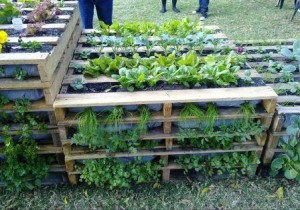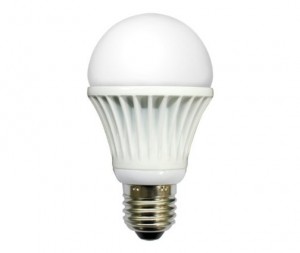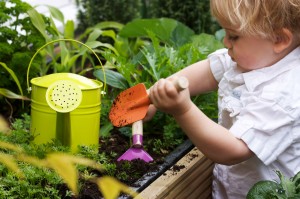More and more people are going back to growing their own gardens. With the move to eating more organically, and taking care of our planet, many are reconnecting to the Earth. Nurturing and growing flowers, fruits and vegetables is increasing. From community to container gardening people are making the most of what they have to produce organic sustainable gardens.
For many though the challenge is space. With the newer houses and smaller yards – to put in a decent garden would take up a good part or all the yard space! Not to mention people who are in apartments or condos, where do you put it?
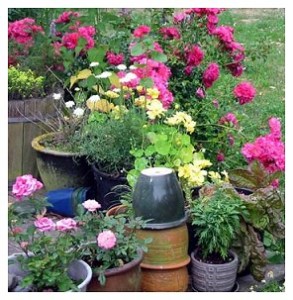 With container gardening being one solution, the newest discovery is pallet gardening, using an old pallet to grow plants or vegetables in. When I first learned about this last year I thought this was a really great idea. It allowed me to put the pallet wherever I wanted, so it did not take up space on my grass, I could expand my garden and grow more! and it was using materials that were easy to find and inexpensive. I could also move it around if I wanted to, though a bit heavy it’s great to have that option.
With container gardening being one solution, the newest discovery is pallet gardening, using an old pallet to grow plants or vegetables in. When I first learned about this last year I thought this was a really great idea. It allowed me to put the pallet wherever I wanted, so it did not take up space on my grass, I could expand my garden and grow more! and it was using materials that were easy to find and inexpensive. I could also move it around if I wanted to, though a bit heavy it’s great to have that option.
To make your own pallet garden you need:
- an old pallet
- landscape fabric
- stapler
- dirt
- whatever you would like to plant
When you are looking for a pallet, you want one that is in good condition, not rotting, nails sticking out or broken boards. (And if you are growing vegetables in it you should opt for one that is heat treat as opposed to fumigated).
Measure out landscape fabric so that it covers the back and up the sides. Do this twice, as using a double layer will make it more durable and stronger. Once you have the fabric to size, put both pieces on top of one another and staple along the bottom, doing one corner, then pulling it taught and securing the opposite corner, etc. until all corners are secured. Then go along the bottom edge of the rest of the pallet. Pull the fabric taught and staple the sides.
Flip the pallet over and fill it with dirt. I would recommend a bag of dirt from your local garden center as it will contain more nutrients than the soil from your garden/ yard. Soils like organic potting soil or triple mix are excellent choices.
Plant your plants in rows between the slats of your pallet. You can start from seed or plant plants that have already been started inside or purchased. Water pallet well.
Now comes the fun part. If you have planted plants that are already started you can wait a few days until the roots are established then you can move your pallet. You can set it upright against a wall or fence. You could also plant another pallet and stack pallets on top of each other. This takes a bit of planning to ensure that everything is getting enough sun, but it is a great space saver and create a huge garden in a small space.
If you have planted from seed, you will have to wait longer if you wish to stack or put the pallet upright, as things need to be established before doing this.
Remember to water your pallet regularly as they tend to dry out much quicker than your regular garden.
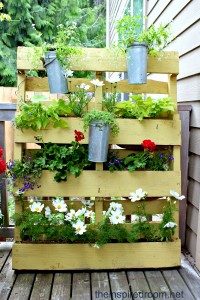 The great thing about pallet gardening is that you can get really creative with it. You can create eye catching designs for vegetable, herb and flower gardens in just about any space! Morning Chores has a fabulous resource with 43 different ideas for all kinds of pallet gardens. There is no end to what you can with your pallet!
The great thing about pallet gardening is that you can get really creative with it. You can create eye catching designs for vegetable, herb and flower gardens in just about any space! Morning Chores has a fabulous resource with 43 different ideas for all kinds of pallet gardens. There is no end to what you can with your pallet!
I also think this is a great way to garden with kids, as they can get really creative. Not only are they able to help you with planting but could also decorate the pallet by painting or suggesting ideas on what to create.
It is also easy and accessible for them. Both Luke and Chloe helped me plant our pallet this year and enjoyed picking the seeds to put in. We usually plant vegetables in our pallet as we love to eat the fresh veggies from the garden. This year we have green and yellow beans, spinach, two kinds of lettuce, and a variety of herbs. Some we started from seed and some were all ready small plants we had purchased.
It sits on our deck which gets lots of sun, but is a great place for the kids to ‘watch’ what is happening as we go by it everyday on our way out to the car. So far our beans have started to come up as well as the spinach. Looking forward to seeing what the harvest brings this year 🙂


